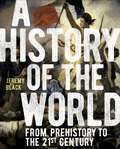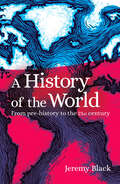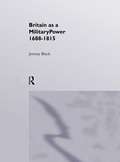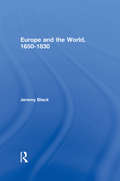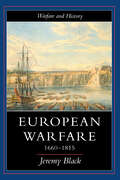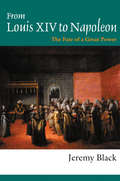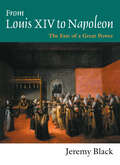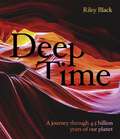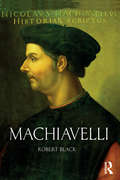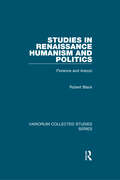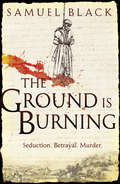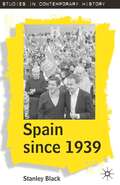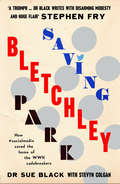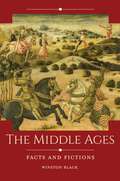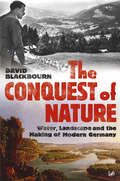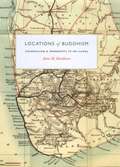- Table View
- List View
A History of the World: From Prehistory to the 21st Century
by Professor Jeremy BlackThroughout the ages, human beings have shown an astonishing capacity to adapt to their environments. Creating great cities, establishing remarkable civilizations, and developing new modes of communication, we have accomplished remarkable feats. At the same time, warfare, discrimination, and poverty reveal the darker side of human nature. From history's most remarkable men and women to bloody wars and genocides, this illustrated volume brings to life an incredible range of human experience over the millennia. Taking inspiration from the latest developments in historiography, Professor Jeremy Black sheds new light on our understanding of the past with a special emphasis on the environment, cities, science, politics, and the mechanics of everyday life.Covering the birth of agriculture in the Nile Valley, the development of empires in Mesopotamia, the fall of Rome, the advance of science in the Islamic world, the rise of international trade along the Silk Roads, and the conflagration of the world wars, among many other topics, A History of the World is an essential source of reference that is sure to both entertain and inform.A History of the World covers the key subjects of world history in eight comprehensive chapters: • Prehistoric Humans• The Ancient World• Classical Civilization• The Middle Ages• Renaissance and Enlightenment• Revolutions and Nationalism• The World at War• The Modern World
A History of the World: From Prehistory to the 21st Century
by Professor Jeremy BlackCriss-crossing the globe from the prehistoric era to the modern day, Professor Jeremy Black takes you on a whirlwind tour of our past, leaving no stone unturned as he brings to life the fascinating history of civilisation. Mankind has accomplished remarkable feats - building great cities, creating beautiful art forms and developing new modes of communication. At the same time, warfare discrimination and poverty reveal the darker side of human nature. This incredible illustrated volume covers all of the above, from the birth of agriculture to the two world wars, delving into the vast range of human experience over the millennia. A History of the World forms an essential reference guide for modern-day amateur historians, providing a perfect foothold into this sprawling history.
Britain As A Military Power, 1688-1815
by Professor Jeremy Black Jeremy BlackIn 1688, Britain was successfully invaded, its army and navy unable to prevent the overthrow of the government. 1815, Britain was the strongest power in the world with the most succesful navy and the largest empire. Britain had not only played a prominent role in the defeat of Napoleonic France, but had also established itself as a significant power in South Asia and was unsurpassed in her global reach. Her military strength was related to, and based on, one of the best systems of public finance in the world and held a strong trade position. This illustrated text assesses the military aspects of this shift, concentrating on the multi-faceted nature of the British military effort.; Topics covered include: the rise of Britain; an analysis of military infrastructure; warfare in the British Isles; conventional warfare in Europe; trans- oceanic warfare with European powers; the challenge of America; and the challenge of Revolutionary and Napoleonic France.
Britain As A Military Power, 1688-1815
by Professor Jeremy Black Jeremy BlackIn 1688, Britain was successfully invaded, its army and navy unable to prevent the overthrow of the government. 1815, Britain was the strongest power in the world with the most succesful navy and the largest empire. Britain had not only played a prominent role in the defeat of Napoleonic France, but had also established itself as a significant power in South Asia and was unsurpassed in her global reach. Her military strength was related to, and based on, one of the best systems of public finance in the world and held a strong trade position. This illustrated text assesses the military aspects of this shift, concentrating on the multi-faceted nature of the British military effort.; Topics covered include: the rise of Britain; an analysis of military infrastructure; warfare in the British Isles; conventional warfare in Europe; trans- oceanic warfare with European powers; the challenge of America; and the challenge of Revolutionary and Napoleonic France.
Europe and the World, 1650-1830
by Professor Jeremy Black Jeremy BlackEurope and the World, 1650-1830 is an important thematic study of the first age of globalisation. It surveys the interaction of Europe, Europe's growing colonies and other major global powers, such as the Ottoman Empire, China, India and Japan. Focusing on Europe's impact on the world, Jeremy Black analyses European attitudes, exploration, trade and acquisition of knowledge.
Europe and the World, 1650-1830
by Professor Jeremy Black Jeremy BlackEurope and the World, 1650-1830 is an important thematic study of the first age of globalisation. It surveys the interaction of Europe, Europe's growing colonies and other major global powers, such as the Ottoman Empire, China, India and Japan. Focusing on Europe's impact on the world, Jeremy Black analyses European attitudes, exploration, trade and acquisition of knowledge.
European Warfare, 1660-1815 (Warfare And History Ser.)
by Professor Jeremy Black Jeremy BlackThis is a history of warfare, wars and the armed forces of Europe from the military revolution of the mid-17th century to the Napoleonic wars.; This book is intended for broad-based undergrad courses on 18th century Europe/Britain and the Ancien Regime. 2nd and 3rd year thematic courses on warfare in the modern period, and students of war studies.
European Warfare, 1660-1815
by Professor Jeremy Black Jeremy BlackThis is a history of warfare, wars and the armed forces of Europe from the military revolution of the mid-17th century to the Napoleonic wars.; This book is intended for broad-based undergrad courses on 18th century Europe/Britain and the Ancien Regime. 2nd and 3rd year thematic courses on warfare in the modern period, and students of war studies.
From Louis XIV to Napoleon: The Fate of a Great Power
by Professor Jeremy Black Jeremy BlackMuch of the period 1661-1815 appeared to be the age of France. France was the greatest power in Western Europe in the late seventeenth and eighteenth centuries and Louis XIV and Napoleon seemed to dominate their periods. yet when Louis XIV died in 1715, and again after Napoleon's attempt to resume power was defeated at Waterloo a century later, France appeared as a waning power. This failure in Europe was matched on the world scale. France was overtaken by Britain in the struggle for maritime predominance, and ended the period with her empire in ruins. From Louis XIV to Napoleon is a scholarly yet accessible account which considers why France was not more successful and throws light on French history, international relations, warfare and the rise and fall of French power.
From Louis XIV to Napoleon: The Fate of a Great Power
by Professor Jeremy Black Jeremy BlackMuch of the period 1661-1815 appeared to be the age of France. France was the greatest power in Western Europe in the late seventeenth and eighteenth centuries and Louis XIV and Napoleon seemed to dominate their periods. yet when Louis XIV died in 1715, and again after Napoleon's attempt to resume power was defeated at Waterloo a century later, France appeared as a waning power. This failure in Europe was matched on the world scale. France was overtaken by Britain in the struggle for maritime predominance, and ended the period with her empire in ruins. From Louis XIV to Napoleon is a scholarly yet accessible account which considers why France was not more successful and throws light on French history, international relations, warfare and the rise and fall of French power.
Deep Time: A journey through 4.5 billion years of our planet
by Riley BlackDeep time is the timescale of the geological events that have shaped our planet. Whilst so immense as to challenge human understanding, its evidence is nonetheless visible all around us. Through explanations of the latest research and over 200 fascinating images, Deep Time explores this evidence, from the visible layers in ancient rock to the hiss of static on the radio, and from fossilized shark's teeth to underwater forests. These relics of ancient epochs, many of which we can see and touch today, connect our present to the distant past and answer broader questions about our place in the timeline of the Earth.Charting 4.5 billion years of geological history, this is the story of our world, from its birth to the dawn of civilization.
Machiavelli: The Outsider (Viella Historical Research Ser. #7)
by Robert BlackMachiavelli is history's most startling political commentator. Recent interpreters have minimised his originality, but this book restores his radicalism. Robert Black shows a clear development in Machiavelli's thought. In his most subversive works The Prince, the Discourses on Livy, The Ass and Mandragola he rejected the moral and political values inherited by the Renaissance from antiquity and the middle ages. These outrageous compositions were all written in mid-life, when Machiavelli was a political outcast in his native Florence. Later he was reconciled with the Florentine establishment, and as a result his final compositions including his famous Florentine Histories represent a return to more conventional norms. This lucid work is perfect for students of Medieval and Early Modern History, Renaissance Studies and Italian Literature, or anyone keen to learn more about one of history's most potent, influential and arresting writers.
Machiavelli
by Robert BlackMachiavelli is history's most startling political commentator. Recent interpreters have minimised his originality, but this book restores his radicalism. Robert Black shows a clear development in Machiavelli's thought. In his most subversive works The Prince, the Discourses on Livy, The Ass and Mandragola he rejected the moral and political values inherited by the Renaissance from antiquity and the middle ages. These outrageous compositions were all written in mid-life, when Machiavelli was a political outcast in his native Florence. Later he was reconciled with the Florentine establishment, and as a result his final compositions including his famous Florentine Histories represent a return to more conventional norms. This lucid work is perfect for students of Medieval and Early Modern History, Renaissance Studies and Italian Literature, or anyone keen to learn more about one of history's most potent, influential and arresting writers.
Machiavelli (PDF)
by Robert BlackMachiavelli is history's most startling political commentator. Recent interpreters have minimised his originality, but this book restores his radicalism. Robert Black shows a clear development in Machiavelli's thought. In his most subversive works The Prince, the Discourses on Livy, The Ass and Mandragola he rejected the moral and political values inherited by the Renaissance from antiquity and the middle ages. These outrageous compositions were all written in mid-life, when Machiavelli was a political outcast in his native Florence. Later he was reconciled with the Florentine establishment, and as a result his final compositions including his famous Florentine Histories represent a return to more conventional norms. This lucid work is perfect for students of Medieval and Early Modern History, Renaissance Studies and Italian Literature, or anyone keen to learn more about one of history's most potent, influential and arresting writers.
Studies in Renaissance Humanism and Politics: Florence and Arezzo (Variorum Collected Studies)
by Robert BlackThe fifteen articles republished here exemplify the many directions Robert Black's research in Renaissance studies has taken. The first five studies look at Renaissance humanism, in particular at its origins, and the concept of the Renaissance as well as the theory and practice of historical writing. Black also updates his monograph on the Florentine chancellor, Benedetto Accolti. Machiavelli is the subject of three articles, focusing on his education and career in the Florentine chancery. Next come Black's seminal studies of Arezzo under Florentine rule, revealing the triangular relationship between centre, periphery and the Medici family. Finally, two articles on political thought examine the relative merits of monarchical and republican government for political thinkers on both sides of the Alps.
Studies in Renaissance Humanism and Politics: Florence and Arezzo (Variorum Collected Studies)
by Robert BlackThe fifteen articles republished here exemplify the many directions Robert Black's research in Renaissance studies has taken. The first five studies look at Renaissance humanism, in particular at its origins, and the concept of the Renaissance as well as the theory and practice of historical writing. Black also updates his monograph on the Florentine chancellor, Benedetto Accolti. Machiavelli is the subject of three articles, focusing on his education and career in the Florentine chancery. Next come Black's seminal studies of Arezzo under Florentine rule, revealing the triangular relationship between centre, periphery and the Medici family. Finally, two articles on political thought examine the relative merits of monarchical and republican government for political thinkers on both sides of the Alps.
The Ground is Burning
by Samuel BlackSeduction, betrayal and murder: the true art of the renaissance.Cesare Borgia, Niccolo Machiavelli and Leonardo da Vinci - three of the most famous, or notorious, names in European history. In the autumn of 1502, their lives intersect in a castle in Italy's Romagna. In this hugely intelligent and entertaining novel, Samuel Black tells the true story of these men who, with different tools - ruthless ambition, unstoppable genius and subtle political manipulation - each follow an obsession to attain greatness and leave a lasting mark on the world. And at the centre of this court of intrigue and deception is Dorotea Caracciolo, a young noblewoman abducted by Borgia who has become his lover - and his secret agent.Their story begins in hope and fear and ends in bloodshed, deceit and triumph. Along the way, there are battles and romances, lavish parties and furtive stranglings. And out of this maelstrom will emerge the Mona Lisa and The Prince.
Spain Since 1939: From Margins to Centre Stage (Studies in Contemporary History)
by Stanley BlackSpain since 1939 provides students with a comprehensive guide to one of the most exciting historical narratives of the twentieth century: Spain's development from poverty and isolation after the Civil War to its current role as a key player on the European and world stages. Incorporating the most relevant existing research, Stanley Black covers the modern political, cultural and social events that have shaped Spain's evolution through to the present day. This essential introduction charts momentous periods such as:• the violence and repression of the post-war years• the durability of the dictatorship of general Franco• one of the most successful transitions to democracy• the post-transition boom and integration into the European Union.As this fresh new study shows, Spain's history continues to fascinate as it transforms itself into one of the most dynamic and progressive societies in Europe while battling with economic vulnerability, the phenomenon of mass immigration, and the painful buried legacy of its Civil War past.
Loco Spotter’s Guide
by Stuart BlackSince the 1800s locomotives have steamed, chugged and sparked their way into the nation's affections. These powerful engines were the drivers of the Industrial Revolution, and to the present day carry passengers and freight to every corner of Britain.But do you know your Locomotion from your Rocket, or your Gresley Class A4 from your Princess Coronation Class? How heavy is the Flying Scotsman? And who designed the Britannia Class?The Loco Spotter's Guide answers all of these questions, with first-class illustrations portraying more than 60 of the most important steam, diesel and electric designs, including all-important specifications and technical details to aid any would-be loco spotter.
Loco Spotter’s Guide
by Stuart BlackSince the 1800s locomotives have steamed, chugged and sparked their way into the nation's affections. These powerful engines were the drivers of the Industrial Revolution, and to the present day carry passengers and freight to every corner of Britain.But do you know your Locomotion from your Rocket, or your Gresley Class A4 from your Princess Coronation Class? How heavy is the Flying Scotsman? And who designed the Britannia Class?The Loco Spotter's Guide answers all of these questions, with first-class illustrations portraying more than 60 of the most important steam, diesel and electric designs, including all-important specifications and technical details to aid any would-be loco spotter.
Saving Bletchley Park: How #socialmedia saved the home of the WWII codebreakers
by Sue Black Stevyn ColganImagine a Britain where the most important sites of historical significance are replaced with housing estates and supermarkets…Imagine a Britain without Bletchley Park, where Alan Turing and a team of code breakers changed the course of World War II and where thousands of women inspired future generations with their work in the fields of computing and technology...Now imagine a group of extraordinary people, who – seventy years after the birth of the modern computer at Bletchley Park – used technology to spark a social media campaign that helped secure its future and transform it into the world-class heritage and education centre it deserves to be.This is a story about saving Bletchley Park.But it is also the story of the hundreds of people who dedicated twenty years of hard work and determination to the campaign that saved it. It is a testament to the remarkable and mysterious work during World War II that made it a place worth saving. It is a book about campaigners, veterans, enthusiasts, computer geeks, technology, Twitter, trees and Stephen Fry stuck in a lift.And finally, it is a story about preserving the past for the generations of tomorrow.
The Middle Ages: Facts and Fictions (Historical Facts and Fictions)
by Winston BlackThis book guides readers through 10 pervasive fictions about medieval history, provides them with the sources and analytical tools to critique those fictions, and identifies what really happened in the Middle Ages.This book is the first to present fictions about the medieval world to serious students of history. Instead of merely listing myths and stating they are wrong, this volume promotes critical historical analysis of those myths and how they came to be. Each of the ten chapters outlines a pervasive modern myth about medieval European history, describing "What People Think Happened" and "What Really Happened," and illustrating both trends with primary source documents.The book demonstrates that historical fictions also have a history, and that while we need to replace those fictions with facts about the medieval past, we can also benefit from understanding how a fiction about the Middle Ages developed and what that says about our modern perspectives on the past. Through this innovative presentation, readers are introduced to a wide range of sources, from Roman imperial perspectives on the "Fall of Rome" to songs of chivalry and chronicles of the Crusades, scientific treatises on the shape of the Earth and the creation of the universe and early modern stories and textbooks that developed or perpetuated historical myths.
The Middle Ages: Facts and Fictions (Historical Facts and Fictions)
by Winston BlackThis book guides readers through 10 pervasive fictions about medieval history, provides them with the sources and analytical tools to critique those fictions, and identifies what really happened in the Middle Ages.This book is the first to present fictions about the medieval world to serious students of history. Instead of merely listing myths and stating they are wrong, this volume promotes critical historical analysis of those myths and how they came to be. Each of the ten chapters outlines a pervasive modern myth about medieval European history, describing "What People Think Happened" and "What Really Happened," and illustrating both trends with primary source documents.The book demonstrates that historical fictions also have a history, and that while we need to replace those fictions with facts about the medieval past, we can also benefit from understanding how a fiction about the Middle Ages developed and what that says about our modern perspectives on the past. Through this innovative presentation, readers are introduced to a wide range of sources, from Roman imperial perspectives on the "Fall of Rome" to songs of chivalry and chronicles of the Crusades, scientific treatises on the shape of the Earth and the creation of the universe and early modern stories and textbooks that developed or perpetuated historical myths.
The Conquest Of Nature: Water, Landscape, and the Making of Modern Germany
by David BlackbournThe modern idea of 'mastery' over nature always had its critics, whether their motives were aesthetic, religious or environmentalist. By investigating how the most fundamental element - water - was 'conquered' by draining fens and marshes, straightening the courses of rivers, building high dams and exploiting hydro-electric power, The Conquest of Nature explores how over the last 250 years, the German people have shaped their natural environment and how the landscapes they created took a powerful hold on the German imagination. From Frederick the Great of Prussia to Johann Gottfried Tulla, 'the man who tamed the wild Rhine' in the nineteenth century to Otto Intze, 'master dambuilder' of the years around 1900, to the Nazis who set out to colonise 'living space' in the East, this groundbreaking study shows that while mastery over nature delivers undoubted benefits, it has often come at a tremendous cost to both the natural environment and human life.
Locations of Buddhism: Colonialism and Modernity in Sri Lanka (Buddhism and Modernity)
by Anne M. BlackburnModernizing and colonizing forces brought nineteenth-century Sri Lankan Buddhists both challenges and opportunities. How did Buddhists deal with social and economic change; new forms of political, religious, and educational discourse; and Christianity? And how did Sri Lankan Buddhists, collaborating with other Asian Buddhists, respond to colonial rule? To answer these questions, Anne M. Blackburn focuses on the life of leading monk and educator Hikkaduve Sumangala (1827–1911) to examine more broadly Buddhist life under foreign rule. In Locations of Buddhism, Blackburn reveals that during Sri Lanka’s crucial decades of deepening colonial control and modernization, there was a surprising stability in the central religious activities of Hikkaduve and the Buddhists among whom he worked. At the same time, they developed new institutions and forms of association, drawing on pre-colonial intellectual heritage as well as colonial-period technologies and discourse. Advocating a new way of studying the impact of colonialism on colonized societies, Blackburn is particularly attuned here to human experience, paying attention to the habits of thought and modes of affiliation that characterized individuals and smaller scale groups. Locations of Buddhism is a wholly original contribution to the study of Sri Lanka and the history of Buddhism more generally.
